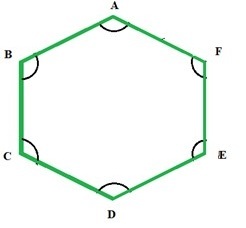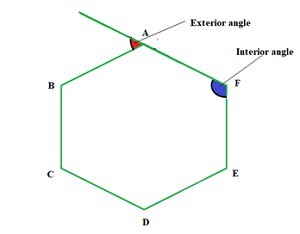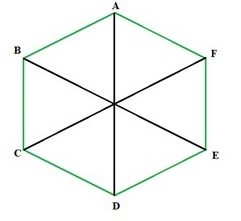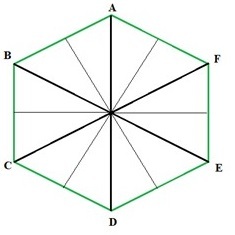
 Data Structure
Data Structure Networking
Networking RDBMS
RDBMS Operating System
Operating System Java
Java MS Excel
MS Excel iOS
iOS HTML
HTML CSS
CSS Android
Android Python
Python C Programming
C Programming C++
C++ C#
C# MongoDB
MongoDB MySQL
MySQL Javascript
Javascript PHP
PHP
- Selected Reading
- UPSC IAS Exams Notes
- Developer's Best Practices
- Questions and Answers
- Effective Resume Writing
- HR Interview Questions
- Computer Glossary
- Who is Who
Regular Hexagon
Introduction
If a polygon has an equal two-dimensional closed shape formed if all the sides and interior angles of the polygons are equal, they are known as regular polygons. A Square, and an equilateral triangle are some of the examples of regular polygons. A regular hexagon is a closed shape polygon which has six equal sides and six equal angles. In this tutorial we will learn about a regular hexagon, angles of a regular hexagon, exterior angles of a regular hexagon, diagonals and line of symmetries of a regular hexagon, hexagonal tiling, hexagons in real life, and some related solved examples.
Regular Hexagons
The word "Hexagon" means "hex" means six and "gonia" means corners, A Hexagon may be defined as a six-sided figure in a two-dimensional geometry. A regular hexagon is a hexagon which has six sides of equal length and also equal interior angles. A regular hexagon consists of six equilateral triangles. A regular hexagon is a two-dimensional figure which has six sides, six interior angles and six vertices. A honeycomb, floor tiles and a clock are some examples of a regular hexagon.

Angles of Hexagon
There are two types of angles subtended by a hexagon: interior angles and exterior angles. A regular polygon consists of six interior angles and six exterior angles. The sum of all the interior angles of a regular hexagon is 720°, and the sum of all the exterior angles of a regular hexagon is 360 °.
As the angles of a regular polygon are all equal, each angle of a regular hexagon can be calculated by 720° ÷ 6 = 120°. Similarly an exterior angle of a regular hexagon can be calculated by 360° ÷ 6 = 60°.

Exterior Angles of Hexagon
As shown in the figure, if a side of a regular hexagon is extended it subtends an angle with the adjacent side of the hexagon, such an angle is called the exterior angle of the hexagon.
Exterior angle of a regular hexagon is calculated by
Exterior angle= sum of all the exterior angles/6.
=360°/6
=60°
Therefore, the exterior angle of a regular hexagon is 60°.
Number of Diagonals of Hexagon
A diagonal is a line drawn on a closed shape figure by joining the vertices opposite to each other. The diagonals of a regular also can be drawn similarly for a regular hexagon. There are nine diagonals in a regular hexagon, for six vertices. When all the diagonals are drawn, they divide the regular hexagon into six equilateral triangles. As shown in the figure the diagonals make a 60 degrees angle at the centre.
Diagonals of a polygon can be calculated by n(n-3)/2.

Lines of Symmetry of a Hexagon
Line of symmetry may be defined as a line passing through the centre of a figure which divides the figure into two identical halves. As shown in the figure, the lines of symmetry when drawn for a regular hexagon gives six lines of symmetry.

Regular Hexagons Tile the Plane Periodically
Hexagonal tiling of a Euclidean plane can be defined as a regular tiling where one vertex is shared by three hexagons. We can tell this by dividing 360 by the interior angle of the polygon, in this case 120 degrees. The regular tiling of a Euclidean plane can be done in three ways, namely, by equilateral triangles, squares, and regular hexagons. Hexagonal Tiling has a 6-fold symmetry i.e. the Hexagonal tiling can be turned by 60o 6 times and the tiling would always look similar to the original. Hexagonal tiling, also known as hexagonal tessellation, was named as Hextille by a renowned mathematician John Conway.
Hexagons in Real Life
We can see hexagonal patterns all around us in nature as well as in artificial structures. Hexagonal structures fit each other without any gaps, when we tile a plane. For this reason, the cells of a honeycomb are hexagonal because a hexagonal shape can make an efficient use of space. In the structure of chemical compounds, graphene has a hexagonal grid crystalline structure. Another example of a chemical compound is benzene, which is a carbon compound with a hexagonal molecular structure, and is considered one of the strongest structures in chemistry. Hexagonal shapes have also been used in cosmology, for example, the James Webb Space Telescope, which has 18 hexagonal mirror segments to trap as much light as possible to see the distant stars in the universe.
Solved examples
1.If a regular hexagon has a side with 6 units, calculate its area.
Solution:
As we know,
The area of a regular hexagon is given by $\mathrm{\frac{3\sqrt{3} s^2}{2}}$ square units, where s represents the unit length of the side.
Given, side s = 6 units.
Therefore, area $\mathrm{A=\frac{3\sqrt{3} s^2}{2}}$
$$\mathrm{A=\frac{3\sqrt{3} 6^2}{2}}$$
=54?3 square units.
Therefore, the area of the regular hexagon is 54?3 square units.
2.Find the length of each side of a regular hexagon, if its area is 72?3 square units.
Solution:
The area of a regular hexagon is given by $\mathrm{\frac{3\sqrt{3} s^2}{2}}$ square units, where s represents the unit length of the side.
Therefore, $\mathrm{72\sqrt{3}=\frac{3\sqrt{3} s^2}{2}}$
$$\mathrm{72=\frac{3}{2} s^2}$$
72Ã2=3s2
48=s2
s=4?3
Therefore, the length of side of the hexagon is 4?3.
Conclusion
If a polygon has equal two-dimensional closed shape formed If all the sides and interior angles of the polygons are equal, they are known as regular polygons. A regular hexagon is a closed shape polygon which has six equal sides and six equal angles. The word "Hexagon" means "hex" means six and "gonia" means corners. A regular polygon consists of six interior angles and six exterior angles. The sum of all the interior angles of a regular hexagon is 720 degrees, and the sum of all the exterior angles of a regular hexagon is 360 degrees. There are three diagonals for each regular hexagon. the lines of symmetry when drawn for a regular hexagon gives six lines of symmetry.
FAQs
1. What is the perimeter of a regular hexagon?
The perimeter of a regular hexagon can be calculated by multiplying the side of the regular hexagon by 6.
2. Define internal and external angles of a regular hexagon.
The internal angle of a regular hexagon is 120 degrees, and the external angle is equal to 60 degrees.
3. What is a real life example of a regular hexagon?
A regular hexagon can be seen in micrographs of snowflakes, and also in the honeycomb structure.
4. How is a hexagon related to an equilateral triangle?
A regular hexagon consists of six equilateral triangles, which can be drawn by joining the diagonals of the regular hexagon.
5. How many lines of symmetry does a regular polygon have?
There are 6 lines of symmetry of a regular hexagon.

